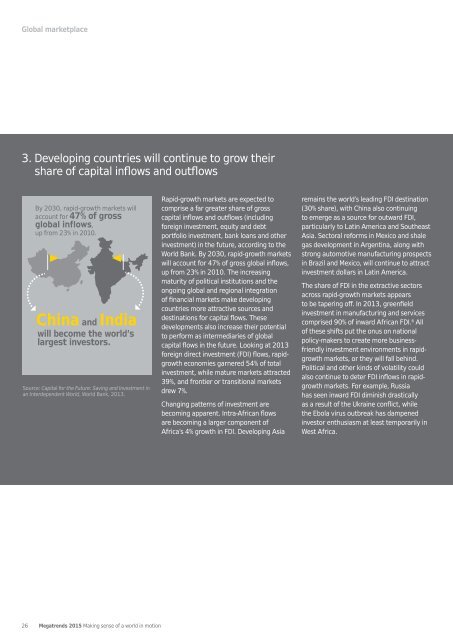ey-megatrends-report-2015
ey-megatrends-report-2015
ey-megatrends-report-2015
You also want an ePaper? Increase the reach of your titles
YUMPU automatically turns print PDFs into web optimized ePapers that Google loves.
Global marketplace<br />
3. Developing countries will continue to grow their<br />
share of capital inflows and outflows<br />
By 2030, rapid-growth markets will<br />
account for 47% of gross<br />
,<br />
up from 23% in 2010.<br />
China and India<br />
will become the world’s<br />
largest investors.<br />
Source: Capital for the Future: Saving and Investment in<br />
an Interdependent World, World Bank, 2013.<br />
Rapid-growth markets are expected to<br />
comprise a far greater share of gross<br />
capital inflows and outflows (including<br />
foreign investment, equity and debt<br />
portfolio investment, bank loans and other<br />
investment) in the future, according to the<br />
World Bank. By 2030, rapid-growth markets<br />
will account for 47% of gross global inflows,<br />
up from 23% in 2010. The increasing<br />
maturity of political institutions and the<br />
ongoing global and regional integration<br />
of financial markets make developing<br />
countries more attractive sources and<br />
destinations for capital flows. These<br />
developments also increase their potential<br />
to perform as intermediaries of global<br />
capital flows in the future. Looking at 2013<br />
foreign direct investment (FDI) flows, rapidgrowth<br />
economies garnered 54% of total<br />
investment, while mature markets attracted<br />
39%, and frontier or transitional markets<br />
drew 7%.<br />
Changing patterns of investment are<br />
becoming apparent. Intra-African flows<br />
are becoming a larger component of<br />
Africa’s 4% growth in FDI. Developing Asia<br />
remains the world’s leading FDI destination<br />
(30% share), with China also continuing<br />
to emerge as a source for outward FDI,<br />
particularly to Latin America and Southeast<br />
Asia. Sectoral reforms in Mexico and shale<br />
gas development in Argentina, along with<br />
strong automotive manufacturing prospects<br />
in Brazil and Mexico, will continue to attract<br />
investment dollars in Latin America.<br />
The share of FDI in the extractive sectors<br />
across rapid-growth markets appears<br />
to be tapering off. In 2013, greenfield<br />
investment in manufacturing and services<br />
comprised 90% of inward African FDI. 6 All<br />
of these shifts put the onus on national<br />
policy-makers to create more businessfriendly<br />
investment environments in rapidgrowth<br />
markets, or th<strong>ey</strong> will fall behind.<br />
Political and other kinds of volatility could<br />
also continue to deter FDI inflows in rapidgrowth<br />
markets. For example, Russia<br />
has seen inward FDI diminish drastically<br />
as a result of the Ukraine conflict, while<br />
the Ebola virus outbreak has dampened<br />
investor enthusiasm at least temporarily in<br />
West Africa.<br />
26 Megatrends <strong>2015</strong> Making sense of a world in motion


